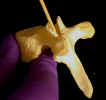

 Lateral view, cervical vertebra
Lateral view, cervical vertebra Superior
view, cervical vertebra
Superior
view, cervical vertebra
 Lateral view, thoracic vertebra
Lateral view, thoracic vertebra Lumbar
vertebrae
Lumbar
vertebrae Superior view, lumbar vertebra
Superior view, lumbar vertebra Posterior
view, lumbar vertebra
Posterior
view, lumbar vertebra Lateral
view, sacrum
Lateral
view, sacrumA facet is a flat or nearly flat surface on a bone. The vertebral articular facets are where two vertebrae articulate. There will be one pair of facets on the superior side of the vertebrae and one pair on the inferior side of the vertebrae. These facets are on an oblique plane in the cervical region, nearly a coronal plane in the thoracic region, and in a sagittal plane in the lumbar region. The oblique plane of the cervical vertebrae increase the range of motion possible for the neck. This is important functionally because it increases the range of motion that we have in the cervical region including rotation, lateral flexion, flexion, and extension. The coronal plane of the thoracic vertebrae effectively prevents flexion and extension, but does allow for rotation of the vertebral column. Lateral flexion should be possible, but this motion is prevented by the presence of the ribs. Functionally, the limited movement of thoracic vertebrae is important to provide a volume in which the lungs and heart can undergo changes in volume without risk of compression. The sagittal plane of the lumbar vertebrae allow for the most flexibility in anterior/posterior direction.
COPYRIGHT
2007 by William C. Johnson II
ALL RIGHTS RESERVED!